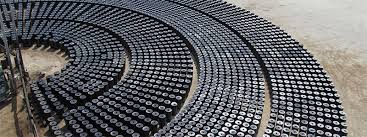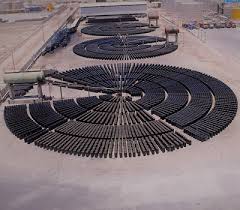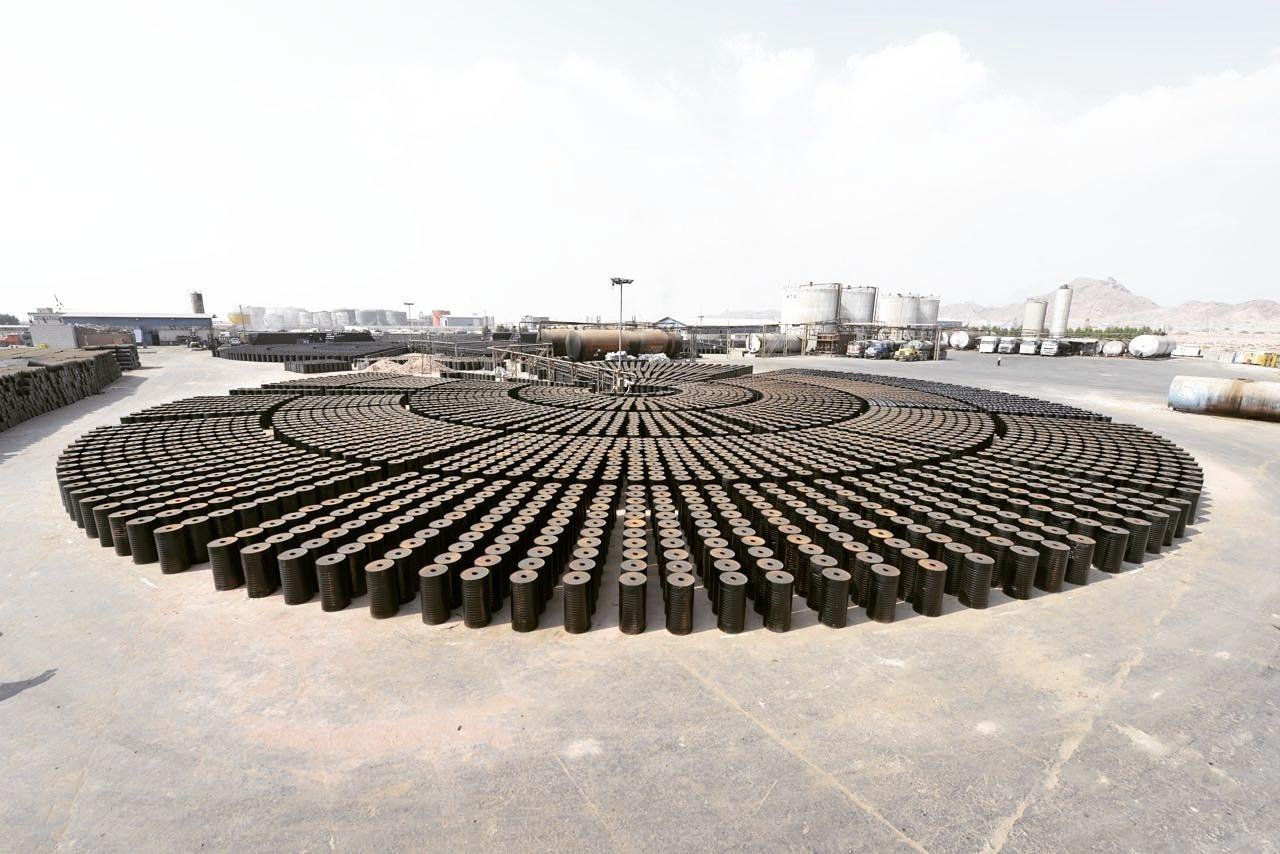
Oxidized Bitumen 85/25
Oxidized Bitumen 85/25 or Oxidized Asphalt is produced by blowing hot air into the penetration bitumen. This action makes the bitumen more rubbery than its original formula and it becomes harder bitumen. This bitumen recovery the weight loss under heating.
Due to low thermal sensitivity, the softening point is much higher than regular bitumen and the penetration index (PI) is higher than road construction bitumen (8>PI>2) due to the letter has a gel-like structure because of asphalt accumulation.
Oxidized Bitumen 85/25 is produced by the air-blowing of penetration grade bitumen. This is done at high temperatures, resulting in a material of a much higher penetration index.
Chemical Mine World Oxidized Bitumen 85/25 is based on petroleum bitumen which is made by blowing bitumen 60/70 by very hot air.
The designation of the Oxidized Bitumen 85/25 refers to the midpoint of the softening point acceptance criteria.
Chemical Mine World Oxidized Bitumen 85/25 is produced by either Continuous or Staggered Blowing Process. Heated Penetration Grade Bitumen under controlled environment is blown with air which controls the Oil Content in the Bitumen while it oxidized. The different grades for suited applications produced are designated by two numbers to indicate the mid-points of their softening point and penetration ranges.
Blown Asphalt 85-25 is based on petroleum bitumen which is made by blowing bitumen 60/70 by very hot air. In addition, the numbers relate to the midpoint of the material’s softening point and penetration respectively. The softening point value measured by Ring and Ball method as determined by ASTM D36. Also, the penetration value is in 1/10 mm as determined by IP49 or ASTM- D5.
Application of Oxidized Bitumen 85/25:
Oxidized Bitumen 85/25 is a solid or semi-black solid material and gradually liquid when heated. Oxidized Bitumen grades are blown or oxidized Asphalt ‘s which are produced by passing air through soft bitumen under controlled temperature conditions. This process gives the bitumen more rubbery properties than penetration or hard grade bitumens and a variety of uses in industrial applications.
Oxidized Bitumen 85/25 is widely used as an anti-slip layer compound in the piling industry, for the manufacture of roofing felts, the roofing and waterproofing industries, for sound dampening felts and under carriage sealant in the automotive industry, electric cable joint protection, joint filling compound, carpet-backing, corrosion protection, acoustic panels, chemical, fuel, Manufacture of paints, sealant compound, and many others. Also used in sealing saw cuts and joints where expected movements are minimum. It is also used in the manufacturing of bituminous marine mastic for the oil & gas pipeline joints. Further, Oxidized Bitumen is used in the manufacture of bituminous marine mastic, which is required for the oil and gas pipeline joints.
Oxidized bitumen is used as sealing of expansion joints.
Oxidized bitumen is used as repair of joints or cracks.
Oxidized bitumen is used as fixation of parquet floors.
Oxidized bitumen is used as adhesive to be used in thermal insulation.
Oxidized bitumen is used as repair of unexposed cracks.
Oxidized bitumen is used as bonding of wet briquettes
Oxidized bitumen is used in various industries like roofing, isolation, insulation flooring, mastics, pipe coatings, electrical applications.
Technical Advantages of Oxidized Bitumen 85/25
- Durability
- Flexibility
- Water Resistant
- Chemical Stability
Compared to paving grade bitumen:
- Reduced temperature susceptibility
- Exhibits a more ‘solid’ nature at ambient temperatures
- High penetration index
Handling / Storage:
Heating of packaged bitumen is a critical phase in most of the final uses. Typically, the packaged material is heated and melted in boilers out on site.
However, control at the heating phase is very important in terms of health and safety as well as in maintaining the quality of the product.
Note must be taken of the maximum safe handling temperature of 230 C and this should not be abused. Bitumen is a poor conductor of heat, consequently, control of the heating phase is of paramount importance.
The Oxidized Bitumen material should be broken up prior to placement in the boiler. This exposes a larger surface area to the heat and encourages a more even heating regime. Without the larger exposed surface area, aggressive heating at the base and sides of the boiler may well result in localized overheating, altering the characteristics of the Chemical Mine World modified bitumen and potentially causing thermal cracking of the bitumen, creating the release of low lash vapors. The flash point of the oxidized bitumen then becomes irrelevant; as these low flash vapors determine the fire risk.
Melted bitumen should not be left in the boiler and reheated from cold, as there is then a high potential for localized overheating around the heating area (lack of convection means poor heat transfer) and potential development of a pressurized pocket of low flash vapors.
Be aware of the placement of any temperature monitoring or control devices. As a result of the poor thermal conductivity of the bitumen, a thermometer in the bitumen some distance from the heat source could read significantly different (even hundreds of degrees) from the true temperature of the bitumen near the heat source.
Health & Safety:
Workers should wear protective masks, gloves, and goggles during application. The asphalt can be removed from equipment and tools with kerosene or gasoline. Care should be taken when heating Oxidized Bitumen 85/25 to avoid overheating. For Health and Safety information, please make reference to the relevant MSDS.
Packing of blown asphalt 85/25:
The Chemical Mine World is manufacturer of blown asphalt 85/25 in various packing including kraft bag, meltable plastic bag, drum and bulk blown asphalt 85/25 from penetration grade bitumen, which is blown by hot air in a controlled process until the desired specification is reached. The Chemical Mine World oxidised bitumen 85/25 can be supplied in any grade and are designated by two numbers to indicate the softening point and penetration ranges. The oxidized asphalt grade 85/25 means softening point is 85°c and penetration is 25 desimillimiter is produced in compliance and conformity to ASTM standard and meets the following specification.
Data Sheet of Oxidized Bitumen 85/25:
| Bitumen 85/25 | Test method | Unit | Specification |
| Specific gravity @25/25 C | ASTM D70 | (Kg/m3) | 1.05 approx. |
| Penetration @ 25°c | ASTM D5 | mm/10 | 20/30 |
| Softening point °c | ASTM D36 | °C | 80/90 |
| Ductility @25 °c | ASTM D113 | Cm | 3 min |
| Loss on heating(wt) % | ASTM D6 | Wt. % | 0.2 max |
| Flashpoint c | ASTM D92 | °C | 250 min |
| Solubility is CS2(wt) % | ASTM D4 | Wt. % | 99.5 max |
| Spot test | A.A.S.H.O.T 102 | — | Negative |

Blown Asphalt 90/40
Blown Asphalt 90/40 is an oxidized Asphalt produced by oxidizing a selected petroleum asphalts without adding the catalyst.Chemical Mine World 90/40 has high softening point, high flash point and it is highly stable during melting.
Blown Asphalt 90/40 is produced by the air-blowing of penetration grade bitumen. This is done at high temperatures, resulting in a material of a much higher penetration index.
Chemical Mine World Oxidized Bitumen 90/40 is based on petroleum bitumen which is made by blowing bitumen 60/70 by very hot air.
The designation of the Oxidized bitumen 95/25 refers to the midpoint of the softening point acceptance criteria.
Oxidized Bitumen is a solid or semi-black solid material and gradually liquid when heated.
Oxidized Bitumen grades are blown or oxidized bitumen‘s which are produced by passing air through soft bitumen under controlled temperature conditions.
This process gives the bitumen more rubbery properties than penetration or hard grade bitumens and a variety of uses in industrial applications.
Chemical Mine World Oxidized Bitumen 90/40 is produced by either Continuous or Staggered Blowing Process. Heated Penetration Grade Bitumen under controlled environment is blown with air which controls the Oil Content in the Bitumen while it oxidized.
The different grades for suited applications produced are designated by two numbers to indicate the mid-points of their softening point and penetration ranges.
Chemical Mine World Oxidized Bitumen 90/40 is based on petroleum bitumen which is made by blowing bitumen 60/70 by very hot air.
In addition, the numbers relate to the midpoint of the material’s softening point and penetration respectively. The softening point value measured by Ring and Ball method as determined by ASTM D36. Also, the penetration value is in 1/10 mm as determined by IP 49 or ASTM- D5.
Chemical Mine World is one of the market leaders in Production, Exports, and brokerage different grades of Blown Asphalt with excellent quality.
Our sales team is committed who understands your requirements due to many years of experience in supplying the bitumen products.
If you are more interested in product information or need to place an order contact or inquire our Sales team.
Application of blown bitumen 90/40:
Blown Asphalt 90/40 is semi-solid oxidized grade of pure petroleum bitumen categorized in polycyclic aromatic hydrocarbons is normally used for different purposes in the construction business.Blown Asphalt 90/40 is widely used as an anti-slip layer compound in the piling industry, for the manufacture of roofing felts, the roofing and waterproofing industries, for sound dampening felts and under carriage sealant in the automotive industry, electric cable joint protection, joint filling compound, carpet-backing, corrosion protection, acoustic panels, chemical, fuel, Manufacture of paints, sealant compound, and many others. Also used in sealing saw cuts and joints where expected movements are minimum. It is also used in the manufacturing of bituminous marine mastic for the oil & gas pipeline joints. Further, Blown Asphalt is used in the manufacture of bituminous marine mastic, which is required for the oil and gas pipeline joints.
Blown Asphalt has several usages in industry:
Oil and Gas industries:
Coating materials for pipelines and pipe joints of Oil Also Gas Pipelines.
Electrical industries:
The sealant of wire coating
Waterproofing industries:
Building roofing felts in factories and first materials components who are producing waterproofing roofing felt sheets
Bitumen and Asphalt:
Road paving, Asphalt, construction.
Making Sound insulation layers.
Car tires and lining.
Technical Advantages of Blown Asphalt 90/40
- Durability
- Flexibility
- Water Resistant
- Chemical Stability
Compared to paving grade bitumen:
- Reduced temperature susceptibility
- Exhibits a more ‘solid’ nature at ambient temperatures
- High penetration index
Handling / Storage:
Heating of packaged bitumen is a critical phase in most of the final uses. Typically, the packaged material is heated and melted in boilers out on site.
However, control at the heating phase is very important in terms of health and safety as well as in maintaining the quality of the product.
Note must be taken of the maximum safe handling temperature of 230 C and this should not be abused. Bitumen is a poor conductor of heat, consequently, control of the heating phase is of paramount importance.
The Oxidized Bitumen material should be broken up prior to placement in the boiler. This exposes a larger surface area to the heat and encourages a more even heating regime. Without the larger exposed surface area, aggressive heating at the base and sides of the boiler may well result in localized overheating, altering the characteristics of the Chemical Mine World modified bitumen and potentially causing thermal cracking of the bitumen, creating the release of low lash vapors.
The flash point of the oxidized bitumen then becomes irrelevant; as these low flash vapors determine the fire risk.
Melted bitumen should not be left in the boiler and reheated from cold, as there is then a high potential for localized overheating around the heating area (lack of convection means poor heat transfer) and potential development of a pressurized pocket of low flash vapors.
Be aware of the placement of any temperature monitoring or control devices. As a result of the poor thermal conductivity of the bitumen, a thermometer in the bitumen some distance from the heat source could read significantly different (even hundreds of degrees) from the true temperature of the bitumen near the heat source.
For Health and Safety information, please make reference to the relevant MSDS.
Health & Safety:
Workers should wear protective masks, gloves, and goggles during application. The asphalt can be removed from equipment and tools with kerosene or gasoline. Care should be taken when heating Blown Asphalt 90/40 to avoid over heating
Packing of blown asphalt 90/40:
The Chemical Mine World is manufacturer of blown asphalt 90/40 in various packing including kraft bag, meltable plastic bag, drum and bulk blown asphalt 90/40 from penetration grade bitumen, which is blown by hot air in a controlled process until the desired specification is reached.
The Chemical Mine World oxidized bitumen 90/40 can be supplied in any grade and are designated by two numbers to indicate the softening point and penetration ranges.
The oxidized asphalt grade 90/40 means softening point is 90°c and penetration is 40 desimillimiter is produced in compliance and conformity to ASTM standard and meets the following specification.
Data Sheet of Blown Asphalt 90/40:
| Bitumen 90/40 | Test method | Unit | Specification |
| Specific gravity @25/25 C | ASTM D70 | (Kg/m3) | 1.05 approx. |
| Penetration @ 25°c | ASTM D5 | mm/10 | 35/45 |
| Softening point °c | ASTM D36 | °C | 85/95 |
| Ductility @25 °c | ASTM D113 | Cm | 5.5 min |
| Loss on heating(wt) % | ASTM D6 | Wt. % | 0.2 max |
| Flash point c | ASTM D92 | °C | 250 min |
| Solubility is CS2(wt) % | ASTM D4 | Wt. % | 99.5 max |
| Spot test | A.A.S.H.O.T102 | — | Negative |

What is cutback bitumen?
Cutback bitumen is a range of binders that are produced by blending (mixing) penetration grade bitumen and a hydrocarbon solvent, such as paraffin or mineral turpentine.
When the solvent has evaporated, the binder returns to its original penetration grade to tie the particles together.
Cutback bitumen gets its name from the solvent that is involved in the process, because the solvent "cuts back" or evaporates, leaving behind the binder to "get on with the job".
The solvent used in cutback bitumen is called the "cutter" or "flux".
Three types of solvents are used for the blending process:
- slow curing (SC)
- medium curing (MC)
- rapid-curing (RC)
Advantage of cutback bitumen:
it can be applied at lower temperatures than penetration grades because of its lower Bitumen Solvents viscosity. A disadvantage is that cutback bitumen consumes non-renewable energy resources which are ultimately lost through evaporation.Applications of Cutback Bitumen:
Prime and Tack Coating The process of priming involves applying a low viscosity binder to a prepared but usually unbound aggregate base.
It is intended to be absorbed by the top layers of the base and provide a surface more easily ‘wetted’ by a subsequent bituminous covering.
The primer will be able to carry traffic for a short time (although this practice is uncommon) and help control dust.
Generally, primers are applied at rates between 0.5 and 1.4 L/m2.
Cutback bitumen's suitable for priming are also used for tack coats, which are applied to an underlying surface to help with the adhesion of subsequent asphalt layer.




